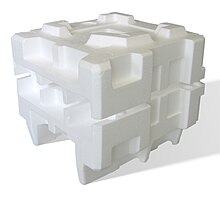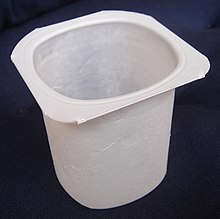
| |

| |

| |
| Names | |
|---|---|
| IUPAC name
Poly(1-phenylethylene)
| |
| Other names
Thermocol
| |
| Identifiers | |
| Abbreviations | PS |
| ChemSpider |
|
| ECHA InfoCard | 100.105.519 |
CompTox Dashboard (EPA)
|
|
| Properties | |
| (C8H8)n | |
| Density | 0.96–1.05 g/cm3 |
| Melting point | ~ 240 °C (464 °F; 513 K)[4] for isotactic polystyrene |
| Boiling point | 430 °C (806 °F; 703 K) and depolymerizes |
| Insoluble | |
| Solubility | Soluble in benzene, carbon disulfide, chlorinated aliphatic hydrocarbons, chloroform, cyclohexanone, dioxane, ethyl acetate, ethylbenzene, MEK, NMP, THF[1] |
| Thermal conductivity | 0.033 W/(m·K) (foam, ρ 0.05 g/cm3)[2] |
Refractive index (nD)
|
1.6; dielectric constant 2.6 (1 kHz – 1 GHz)[3] |
| Related compounds | |
Related compounds
|
Styrene (monomer) |
Except where otherwise noted, data are given for materials in their standard state (at 25 °C [77 °F], 100 kPa).
| |



Polystyrene (PS) /ˌpɒliˈstaɪriːn/ is a synthetic polymer made from monomers of the aromatic hydrocarbon styrene.[5] Polystyrene can be solid or foamed. General-purpose polystyrene is clear, hard, and brittle. It is an inexpensive resin per unit weight. It is a poor barrier to air and water vapor and has a relatively low melting point.[6] Polystyrene is one of the most widely used plastics, with the scale of its production being several million tonnes per year.[7] Polystyrene is naturally transparent, but can be colored with colorants. Uses include protective packaging (such as packing peanuts and optical disc jewel cases), containers, lids, bottles, trays, tumblers, disposable cutlery,[6] in the making of models, and as an alternative material for phonograph records.[8]
As a thermoplastic polymer, polystyrene is in a solid (glassy) state at room temperature but flows if heated above about 100 °C, its glass transition temperature. It becomes rigid again when cooled. This temperature behaviour is exploited for extrusion (as in Styrofoam) and also for molding and vacuum forming, since it can be cast into molds with fine detail. The temperatures behavior can be controlled by photocrosslinking.[9]
Under ASTM standards, polystyrene is regarded as not biodegradable. It is accumulating as a form of litter in the outside environment, particularly along shores and waterways, especially in its foam form, and in the Pacific Ocean.[10]
- ^ Wypych, George (2012). "PS polystyrene". Handbook of Polymers. pp. 541–7. doi:10.1016/B978-1-895198-47-8.50162-4. ISBN 978-1-895198-47-8.
- ^ Haynes 2011, p. [page needed].
- ^ Haynes 2011, pp. 13–17.
- ^ Wunsch, J.R. (2000). Polystyrene – Synthesis, Production and Applications. iSmithers Rapra Publishing. p. 15. ISBN 978-1-85957-191-0. Retrieved 25 July 2012.
- ^ John Scheirs; Duane Priddy (28 March 2003). Modern Styrenic Polymers: Polystyrenes and Styrenic Copolymers. John Wiley & Sons. p. 3. ISBN 978-0-471-49752-3.
- ^ a b "Common Plastic Resins Used in Packaging". Introduction to Plastics Science Teaching Resources. American Chemistry Council, Inc. Retrieved 24 December 2012.
- ^ Cite error: The named reference
Ullmannwas invoked but never defined (see the help page). - ^ "Polystyrene phonograph record and process of manufacture". 22 March 1949. Retrieved 22 September 2021.
- ^ Carroll, Gregory T.; Sojka, Melissa E.; Lei, Xuegong; Turro, Nicholas J.; Koberstein, Jeffrey T. (1 August 2006). "Photoactive Additives for Cross-Linking Polymer Films: Inhibition of Dewetting in Thin Polymer Films". Langmuir. 22 (18): 7748–7754. doi:10.1021/la0611099. ISSN 0743-7463. PMID 16922559.
- ^ Kwon BG, Saido K, Koizumi K, Sato H, Ogawa N, Chung SY, Kusui T, Kodera Y, Kogure K, et al. (May 2014). "Regional distribution of styrene analogues generated from polystyrene degradation along the coastlines of the North-East Pacific Ocean and Hawaii". Environmental Pollution. 188: 45–9. Bibcode:2014EPoll.188...45K. doi:10.1016/j.envpol.2014.01.019. PMID 24553245.